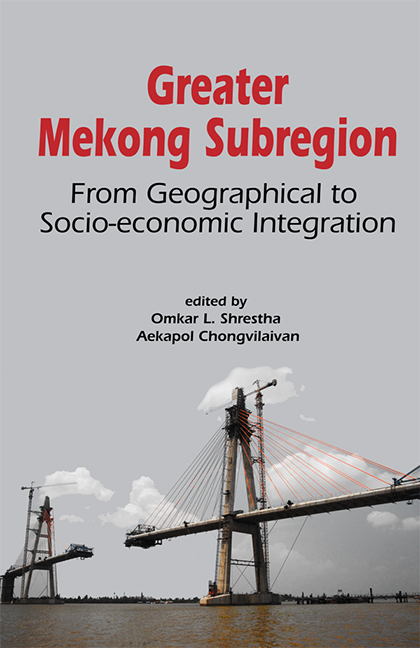Book contents
- Frontmatter
- Contents
- Preface
- List of Abbreviations
- Contributors
- 1 Greater Mekong Subregion: From Geographical Corridors to Socio-economic Corridors
- 2 Cambodia, Its Development, and Integration into the GMS: A Work in Progress
- 3 Subregional Connectivity in the Lao PDR: From Land-locked Disadvantage to Land-linked Advantage
- 4 The Economic Development of Myanmar and the Relevance of the Greater Mekong Subregion
- 5 GMS Challenges for Thailand
- 6 Deepening GMS Cooperation in a More Integrated ASEAN and East Asia
- 7 China (Yunnan)–GMS Economic Cooperation: New Development and New Problems
- 8 Trade and Investment in the Greater Mekong Subregion: Remaining Challenges and the Unfinished Policy Agenda
- 9 Enhancing Financial Cooperation among the GMS Countries
- 10 The Challenges of GMS Regional Integration: Case Study of Governance of the Logistics Industry in Thailand
- 11 Energy Sector Integration for Low-carbon Development in the GMS: Towards a Model of South-South Cooperation
- 12 Linking the Social to the Economic: Broadened Ambitions and Multiple Mitigations in New Mekong Corridors
- Index
12 - Linking the Social to the Economic: Broadened Ambitions and Multiple Mitigations in New Mekong Corridors
Published online by Cambridge University Press: 21 October 2015
- Frontmatter
- Contents
- Preface
- List of Abbreviations
- Contributors
- 1 Greater Mekong Subregion: From Geographical Corridors to Socio-economic Corridors
- 2 Cambodia, Its Development, and Integration into the GMS: A Work in Progress
- 3 Subregional Connectivity in the Lao PDR: From Land-locked Disadvantage to Land-linked Advantage
- 4 The Economic Development of Myanmar and the Relevance of the Greater Mekong Subregion
- 5 GMS Challenges for Thailand
- 6 Deepening GMS Cooperation in a More Integrated ASEAN and East Asia
- 7 China (Yunnan)–GMS Economic Cooperation: New Development and New Problems
- 8 Trade and Investment in the Greater Mekong Subregion: Remaining Challenges and the Unfinished Policy Agenda
- 9 Enhancing Financial Cooperation among the GMS Countries
- 10 The Challenges of GMS Regional Integration: Case Study of Governance of the Logistics Industry in Thailand
- 11 Energy Sector Integration for Low-carbon Development in the GMS: Towards a Model of South-South Cooperation
- 12 Linking the Social to the Economic: Broadened Ambitions and Multiple Mitigations in New Mekong Corridors
- Index
Summary
Rapid social change, in and of itself, is not new to the region as it has been marked historically by imperialism, wars, and multiple migrations. The Upper Mekong, a previously remote area, has often been the subject of ambitious visions of infrastructure development, but, until recently, seldom the site of their realization. In the nineteenth century, British and French colonial authorities sent numerous missions to the region in search of land-based trade routes that might link mainland Southeast Asia to China. The French built a railway from Haiphong to Kunming via the Red River, while the British considered doing the same from northern Thailand. Later in 1937 the Chinese, seeking trade links with India, extended a road from Kunming as far as the Myanmar frontier. Subsequently, World War II, the Communist Revolution in China, and minority rebellions in northeast Myanmar halted further development of cross-border transport and trade connections. Likewise, the Cold War and regional geopolitics further hampered subsequent linkage projects.
But since the 1990s, economic reforms have given renewed impetus to streamlining trading arrangements in the border regions of Thailand, Laos, Vietnam, Cambodia, Myanmar, and southern China. By the turn of the millennium, visions of an integrated economic entity finally began to take shape when the Asian Development Bank launched the Greater Mekong Subregion Program. The initiative aims to build corridors that link the Mekong countries and provide the ability for trade goods, trucks, travellers, and tourists to move rapidly between and through previously remote and hinterland areas of neighbouring states. In a mid-term review of the regional programme, the ADB notes:
The GMS (Greater Mekong Subregion) Program has made very good progress in the “hardware” aspects of cooperation involving the first strategic thrust of the GMS–SF, but less so in the “software” components of cooperation involving the four other thrusts of the GMS–SF, especially in the measures necessary to enhance competitiveness and in activities addressing social and environmental issues in the GMS. This is not surprising, as the initial phases of the GMS Program had placed substantial emphasis on the need to remove the physical barriers to subregional economic cooperation. (ADB 2007, p. viii)
- Type
- Chapter
- Information
- Greater Mekong SubregionFrom Geographical to Socio-economic Integration, pp. 233 - 252Publisher: ISEAS–Yusof Ishak InstitutePrint publication year: 2013



